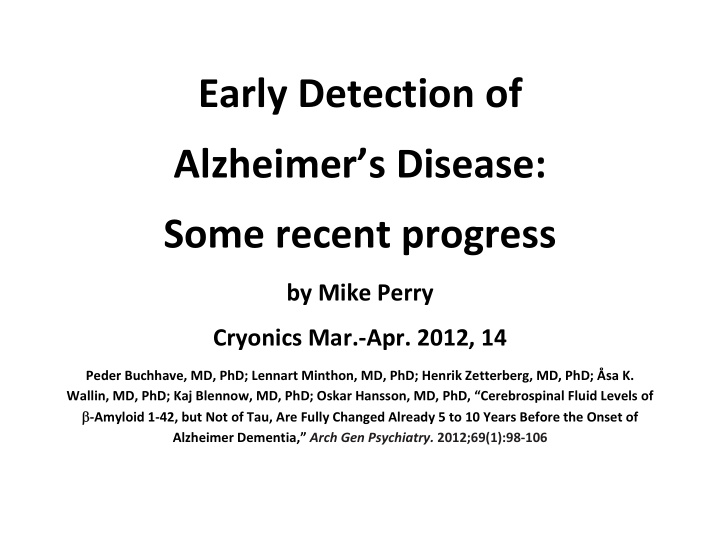



Early Detection of Alzheimer’s Disease: Some recent progress by Mike Perry Cryonics Mar. ‐ Apr. 2012, 14 Peder Buchhave, MD, PhD; Lennart Minthon, MD, PhD; Henrik Zetterberg, MD, PhD; Åsa K. Wallin, MD, PhD; Kaj Blennow, MD, PhD; Oskar Hansson, MD, PhD, “Cerebrospinal Fluid Levels of ‐ Amyloid 1 ‐ 42, but Not of Tau, Are Fully Changed Already 5 to 10 Years Before the Onset of Alzheimer Dementia,” Arch Gen Psychiatry. 2012;69(1):98 ‐ 106
Alzheimer’s disease (AD): Most common dementia No cure Worsens as it progresses Uniformly fatal NOT “terminal illness”(!!!)
7 ‐ 14 years to run its course Detectable, specific symptoms (Symptoms may show up earlier than this but could be from other disorders.)
People over 65 mainly affected 47% 85 & older have AD in U.S. Special Difficulty: Can VSED be used against AD?
Prospects for slowing or curing AD meanwhile remain grim. There is concern that efforts by pharmaceutical companies to develop effective curative treatments may be abandoned.
(There are treatments for the symptoms of AD—for example, to keep one’s mind functioning at a high level longer—but they do not slow, halt, or reverse the disease.)
Though the outlook for slowing or stopping the disease is presently somber, it is not totally bleak, and it could substantially improve within a few years.
Studies of AD in animal models: results based on a kind of immunotherapy (more later). Needed: Early detection of AD
The sooner the disease is detected, the less damage it will have done, which provides more opportunity for therapeutic intervention.
including the sort that has already shown success in animals.
Main Study Reported Here 134 aging patients (“baseline”) mild cognitive impairment (MCI)— Difficulties difficulties remembering recent events etc.
Followed over approximately a decade by a research team at Lund University, Sweden, headed by Physician Oskar Hansson.
Biomarkers—substances present in spinal fluid and linked to AD.
A certain combination of markers, low levels of the substance beta ‐ amyloid (A β ) and high levels of the substance tau, indicate a high risk, about 90%, of developing AD dementia over 9.2 ‐ year period.
Those who had memory impairment but normal values for the markers did not run a higher risk of getting AD than healthy individuals.
Oskar Hansson previously carried out a study showing that pathological changes can be seen in the brain of an AD patient five years before the diagnosis. The new study has nearly doubled this time span.
Extra “lead time”: A larger time window appears to be opened to try approaches that have already shown success in animals.
Some further details of the study are of interest, for which a bit of additional background on AD will be useful.
The normal brain uses a substance known as amyloid precursor protein (APP) in a rapid ‐ fire fashion in which APP molecules are created and then destroyed.
(Just what the APP is used for is not entirely clear, perhaps for such functions as regulation of synapse formation, neural plasticity, and iron export.)
By the time AD starts to develop in a patient the clearing away of the used APP molecules has somehow gone awry.
Fragments known as β‐ amyloid (A β ) begin to pile up in aggregates or heaps known as senile plaques.
Aggregation ‐ prone 42 ‐ amino acid isoform (equivalent form) of A β known as A β 42. Senile plaques average around the size of larger ‐ size neurons (around 50 micrometers) and are thought to be neurotoxic.
In addition to senile plaques the pathologic characteristics of AD include neurofibrillary tangles: insoluble, twisted fibers found inside the neurons containing damaged (hyperphosphoryl ‐ ated) tau protein or P ‐ tau.
Normal, undamaged tau protein is important to stabilize microtubules in the neurons, which in turn is essential to their functioning.
P ‐ tau does not stabilize the microtubules but instead the structure collapses.
Normal tau and P ‐ tau together make up the total tau or T ‐ Tau, a quantity important, together with P ‐ tau and A β 42, in the Hansson study reported here.
To summarize results of study: When [A β 42]/[P ‐ Tau] = small, AD; not small, not ‐ AD
Animal model: success with vaccinating against A β 42, but with humans need extra lead time.
Final thoughts: AD cure would be good, but normal aging also causes dementia. VSED if diagnosed with AD or other brain ‐ threatening ailment
Recommend
More recommend